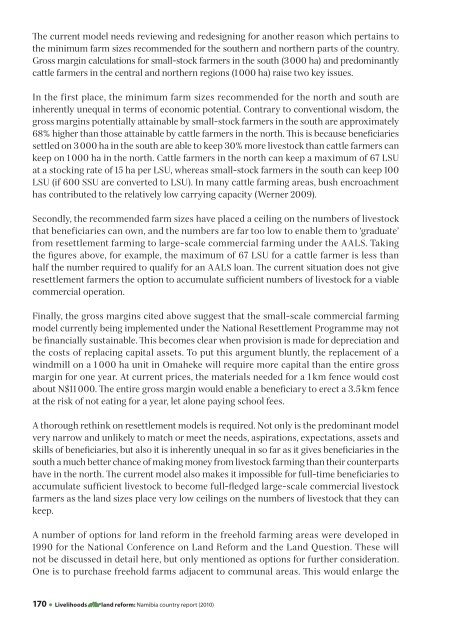Namibia country report
Namibia country report
Namibia country report
- No tags were found...
Create successful ePaper yourself
Turn your PDF publications into a flip-book with our unique Google optimized e-Paper software.
The current model needs reviewing and redesigning for another reason which pertains tothe minimum farm sizes recommended for the southern and northern parts of the <strong>country</strong>.Gross margin calculations for small-stock farmers in the south (3 000 ha) and predominantlycattle farmers in the central and northern regions (1 000 ha) raise two key issues.In the first place, the minimum farm sizes recommended for the north and south areinherently unequal in terms of economic potential. Contrary to conventional wisdom, thegross margins potentially attainable by small-stock farmers in the south are approximately68% higher than those attainable by cattle farmers in the north. This is because beneficiariessettled on 3 000 ha in the south are able to keep 30% more livestock than cattle farmers cankeep on 1 000 ha in the north. Cattle farmers in the north can keep a maximum of 67 LSUat a stocking rate of 15 ha per LSU, whereas small-stock farmers in the south can keep 100LSU (if 600 SSU are converted to LSU). In many cattle farming areas, bush encroachmenthas contributed to the relatively low carrying capacity (Werner 2009).Secondly, the recommended farm sizes have placed a ceiling on the numbers of livestockthat beneficiaries can own, and the numbers are far too low to enable them to ‘graduate’from resettlement farming to large-scale commercial farming under the AALS. Takingthe figures above, for example, the maximum of 67 LSU for a cattle farmer is less thanhalf the number required to qualify for an AALS loan. The current situation does not giveresettlement farmers the option to accumulate sufficient numbers of livestock for a viablecommercial operation.Finally, the gross margins cited above suggest that the small-scale commercial farmingmodel currently being implemented under the National Resettlement Programme may notbe financially sustainable. This becomes clear when provision is made for depreciation andthe costs of replacing capital assets. To put this argument bluntly, the replacement of awindmill on a 1 000 ha unit in Omaheke will require more capital than the entire grossmargin for one year. At current prices, the materials needed for a 1 km fence would costabout N$11 000. The entire gross margin would enable a beneficiary to erect a 3.5 km fenceat the risk of not eating for a year, let alone paying school fees.A thorough rethink on resettlement models is required. Not only is the predominant modelvery narrow and unlikely to match or meet the needs, aspirations, expectations, assets andskills of beneficiaries, but also it is inherently unequal in so far as it gives beneficiaries in thesouth a much better chance of making money from livestock farming than their counterpartshave in the north. The current model also makes it impossible for full-time beneficiaries toaccumulate sufficient livestock to become full-fledged large-scale commercial livestockfarmers as the land sizes place very low ceilings on the numbers of livestock that they cankeep.A number of options for land reform in the freehold farming areas were developed in1990 for the National Conference on Land Reform and the Land Question. These willnot be discussed in detail here, but only mentioned as options for further consideration.One is to purchase freehold farms adjacent to communal areas. This would enlarge the170 ● Livelihoods after land reform: <strong>Namibia</strong> <strong>country</strong> <strong>report</strong> (2010)
















